The Narrative That Says Man-Made CO2
Drives Glacier Melt Continues To Implode
“[T]he retreat of the glaciers after about 1925 became rapid. It was almost entirely during the [pre-1950] twentieth century warming that the Alpine glaciers disappeared from the valley floors up into the mountains. Similarly great retreats occurred in Scandinavia, Iceland, Greenland, in the Americas, and on high mountains near the equator.” — H.H. Lamb Climate, History, and the Modern World (1982), pg. 248
From the middle of the 20th century and through the 1970s, it was common for scientists to report a rapid warming of “nearly 1° C“ between about 1890 and 1940 (Agee, 1980), a warming accompanied by “catastrophic” and “violent” glacier retreat.
In 1959, eminent Princeton geologist Dr. Erling Dorf reported that annual mean U.S. temperatures rose by 3.5°F (+1.9°C) between 1920 and the 1950s (Visher, 1954).
In Antarctica, temperatures rose by 5°F (+2.8°C) from about 1900s to the 1950s (Wexler, 1958).
In the Arctic, temperatures rose by 14°F (+7.8°C) between 1910 and the 1940s (Willett, 1950).
“CLIMATIC CHANGES OF THE PAST AND PRESENT”

Dr. Hans Ahlmann (1953) provided a graphical representation of a pronounced Northern Hemisphere-wide glacier retreat that largely commenced in the 1850s and was ongoing as of 1950.
“Glacier Variations and Climatic Fluctuations“
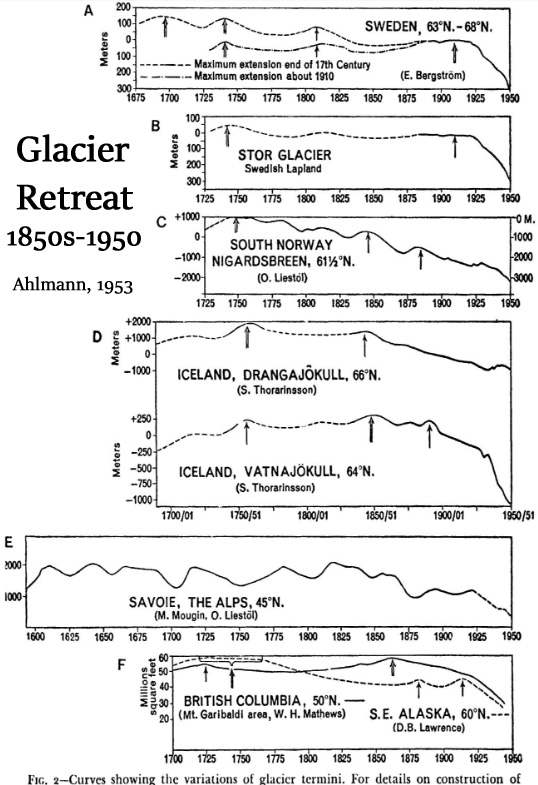
Changing The Temperatures To Fit The Models
The geologically-affirmed existence of an explosive 19th to early 20th century warming accompanied by a “violent” and “catastrophic” wide-scale glacier retreat is not convenient to the computer model-based narrative that says the rise in anthropogenic CO2 emissions is predominantly what causes dangerous warming and glacier retreat.
So the overseers of the global temperature data sets decided the explosive late 19th to mid-20th century warming and “violent” and “catastrophic” glacier retreat needed to be removed from the scientific record.
Even as late as 1987, global data sets depicted a 0.5°C warming between 1880 and 1950. By 2014, all of the 1880 to 1950 warming (0.5°C) had been removed from NOAA’s representation of global temperatures.
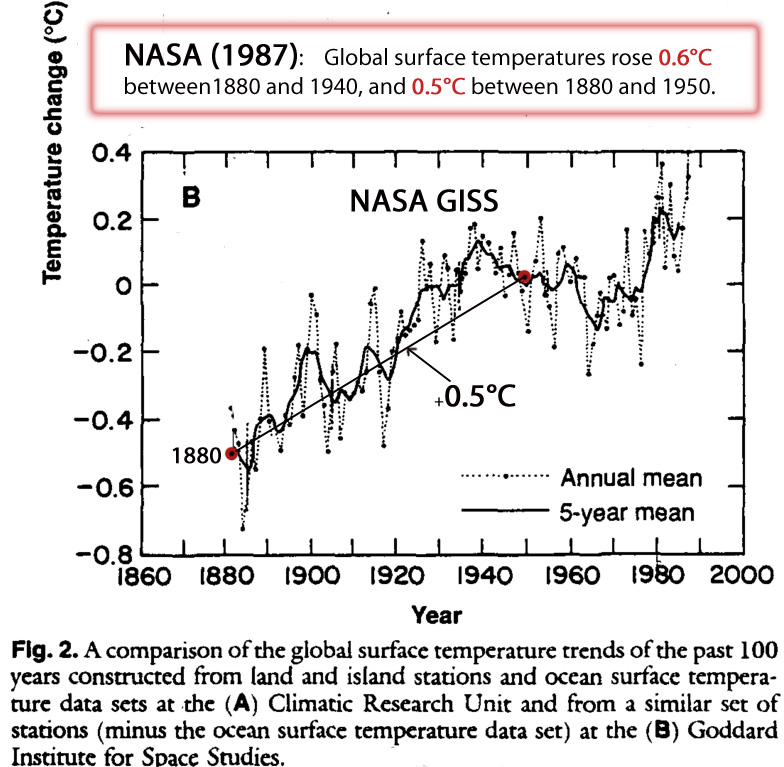
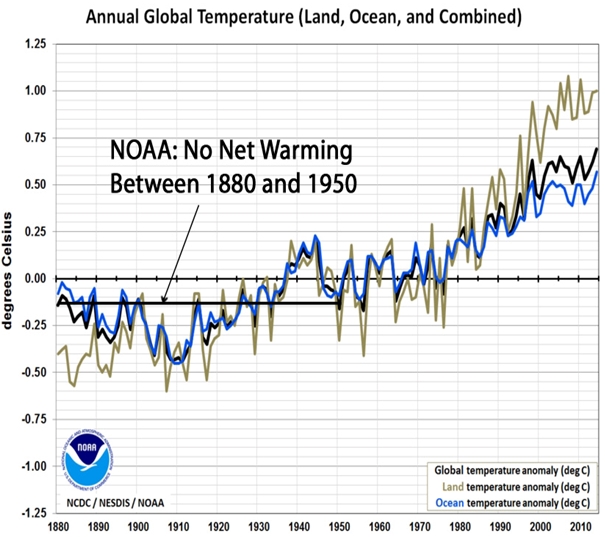
Images: Schneider, S. H. 1989 and NOAA (2014)
Scientists Continue To Uncover Inconvenient Glacier Retreat Data
The scientific literature is teeming with geological evidence affirming the explosive warming and glacier retreat during the 1850 to 1950 period. In other words, scientists are not providing support or confirmation for the narrative that says the post-1940s anthropogenic CO2 emissions increase has coincided with unusual, unprecedented, or alarming glacier retreat.
(1) Rates of glacier recession the second half of the 19th century similar to recent decades.
Oliva et al., 2018
“[T]he Maunder Minimum coincided with a cold period from 1645 to 1706, and the Dalton Minimum (1796–1830) is correlated with a cold stage spanning the years from 1810 to 1838. Four warm periods (1626–1637, 1800–1809, 1845–1859, and 1986–2012) coincided with periods of increased solar activity.”
“The gradual increase in temperature during the second half of the 19th century resulted in significant glacier retreat, with rates of receding [in the second half of the 19th century] similar to those recorded during the last decades of the 20th century and in the early 21st century (Chueca et al., 2008). … The colder climate of the LIA was accompanied by severe droughts, floods, and cold/heat waves that showed significant spatio-temporal variation across the Iberian mountains. … The 20th century did not show unprecedented warmth over the last 800 years.”
(2) Alpine glaciers receded more during the 1860s-1880s and 1920s-1950s than in recent decades, and the Alps are over 3°C colder now than a few thousand years ago.
Sigl et al., 2018
“No role for industrial black carbon in forcing 19th century glacier retreat in the Alps … Starting around 1860 AD, many glaciers in the European Alps began to retreat from their maximum mid-19th century terminus positions, thereby visualizing the end of the Little Ice Age in Europe. Radiative forcing by increasing deposition of industrial black carbon to snow has been suggested as the main driver of the abrupt glacier retreats in the Alps. … Our study reveals that in 1875 AD, the time when European rBC [industrial black carbon] emission rates started to significantly increase, the majority of Alpine glaciers had already experienced more than 80% of their total 19th century length reduction. Industrial BC emissions can, therefore, not been considered as the primary forcing for the rapid deglaciation at the end of the Little Ice Age in the Alps.”
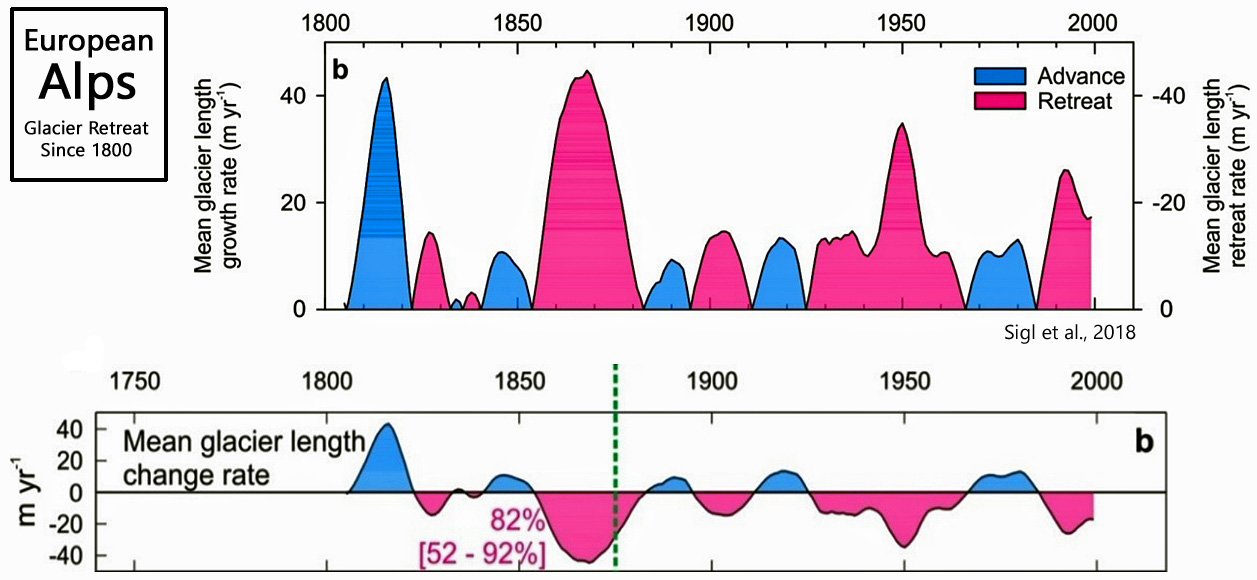
Badino et al., 2018
“Between ca. 8.4-4 ka cal BP [8,400 to 4,000 years before present], our site [Italian Alps] experienced a mean TJuly of ca. 12.4 °C, i.e. 3.1 °C warmer than today [9.3 °C]. … Between 7400 and 3600 yrs cal BP, an higher-than-today forest line position persisted under favorable growing conditions (i.e. TJuly at ca. 12 °C).”
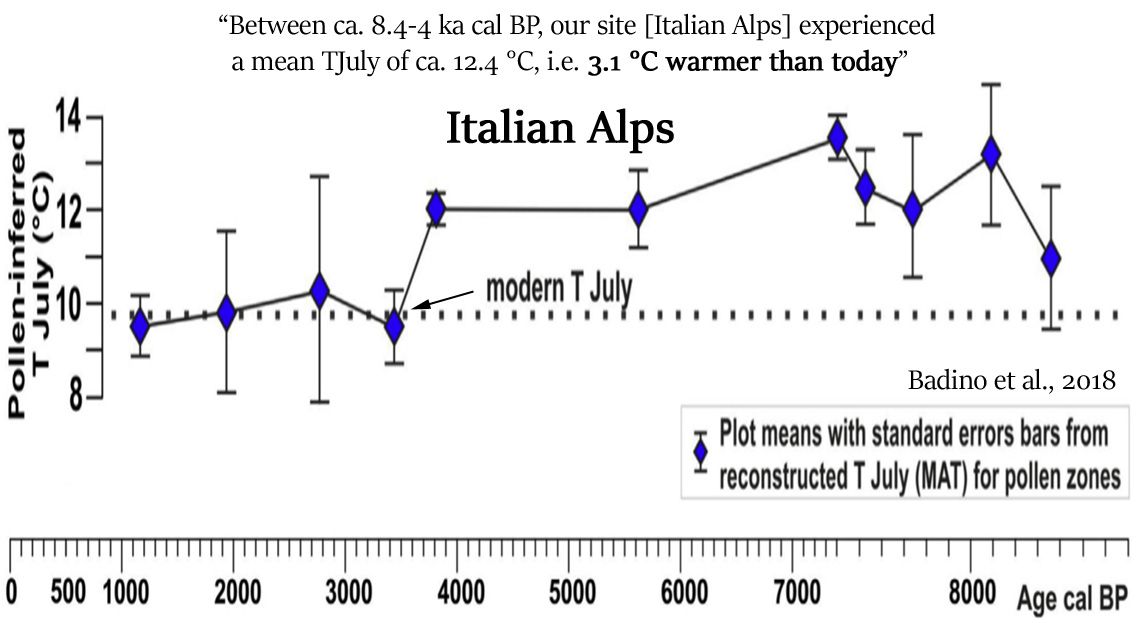
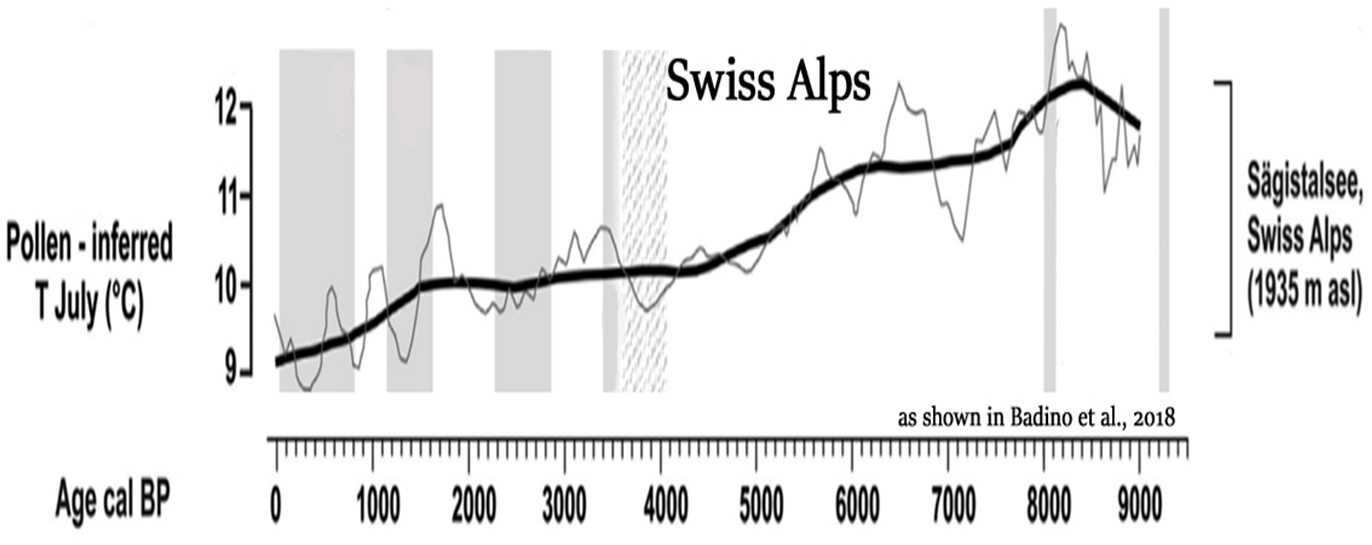
(3) Iceland’s glaciers retreated (more than) 3 times faster from 1860s-1946 than from 1947-2005
Fernández-Fernández et al., 2017
“The abrupt climatic transition of the early 20th century and the 25-year warm period 1925–1950 triggered the main retreat and volume loss of these glaciers since the end of the ‘Little Ice Age’. Meanwhile, cooling during the 1960s, 1970s and 1980s altered the trend, with advances of the glacier snouts. Stötter et al. (1999) indicate that the coldest period after the LIA was from the early 1960s to the mid-1970s, when temperatures fell to levels equivalent to the warmest recorded in the 19th century. This cooling is the reason given by Caseldine (1983, 1985a, 1985b, 1988) to explain the advance of the Gljúfurárjökull between the mid-1970s and the mid-1980s … Studies of aerial photographs and satellite images show that the glacier snouts have retreated by more than 1300 m on average since the LIA maximum (considered to be AD 1898 in Gljúfurárjökull and AD 1868 in both Western and Eastern Tungnahryggsjökull), with an altitudinal rise of more than 100 m. The retreat accelerated rapidly (15.3 m yr−1) during the first half of the 20th century. In the second half of the 20th century, the retreat decelerated considerably [4.7 m yr-1], reflected in the lowest values around 1985 (5.2 m yr−1) and a trend shift in 1994, with an advance observed in Gljúfurárjökull. … The trend in Western Tungnahryggsjökull during the first half of the 20th century was a more rapid retreat, showing the highest average rates of the whole period (19.5 m yr−1). … By 1946, this glacier had retreated almost 90% of the total recorded between the LIA maximum (1868) and 2005.”
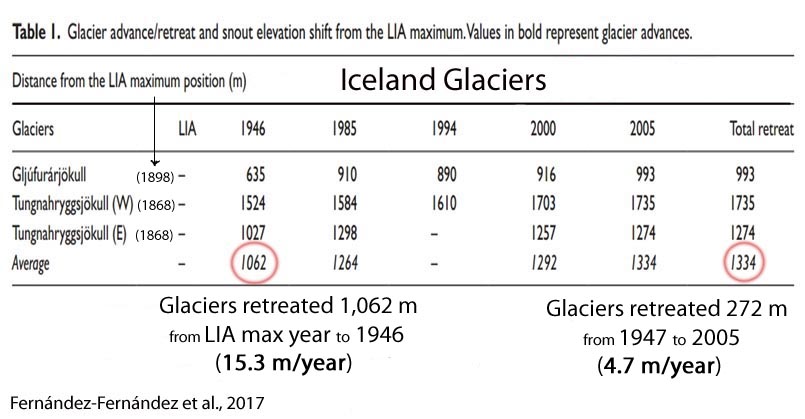
(4) Norway’s glaciers are currently more advanced than nearly all of the last 10,000 years, with pronounced recession occurring during the 1800s.
Gjerde et al., 2016
(5) On a global scale, glacier recession rates have dramatically decelerated since the 1920s to 1950s period.
Leclercq et al., 2014
“A data set of worldwide glacier length fluctuations … The data set contains the glacier length records for 471 [global] glaciers and it covers the period 1535–2011. There are glacier length records from all continents and at almost all latitudes. For the observed glaciers, the 20th century retreat was strongest in the first half of the 20th century.”
“[T]he retreat is strongest in the period 1921–1960 rather than in the last period 1961–2000, with a median retreat rate of 12.5 m yr in 1921–1960 and 7.4 m yr in the period 1961–2000.”
A Human-Driven Glacier Retreat Is Not Supported By Evidence
Advocates of the position that humans exert a profound and dangerous influence on the Earth’s temperatures and glacier melt point to the rapid increase in human CO2 emissions (purple trend line) as the condemnable culprit.

The trend in anthropogenic CO2 emissions was essentially flat and very low (averaging just 1 gigaton of carbon [GtC] per year) from about 1900 to 1945, when a significant portion of the modern glacier recession occurred. Emissions rates were negligible during the high-melt-volume 19th century too.
Explosive growth in human emissions occurred after 1945, when a significant deceleration in glacier melt (and even decades of advancing glaciers) occurred.
This historical evidence would not appear to support the position that anthropogenic CO2 emissions drive both warming and glacier melt.
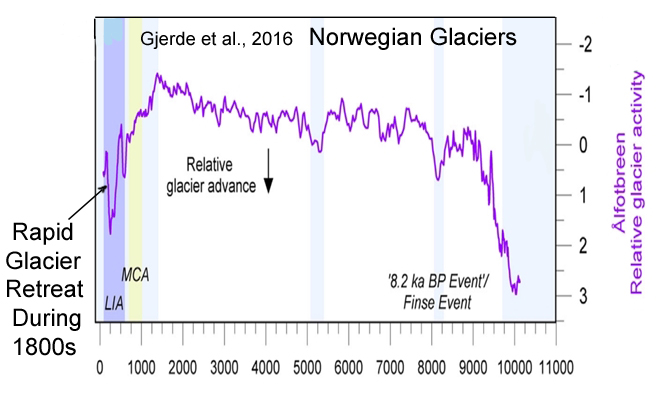





DNFTT
So why do you think it is that East Antarctica has been cooling (“ubiquitous cooling across East Antarctica” [Clem et al., 2018]) and gaining mass for the last several decades? The Western Antarctic Peninsula’s surface air temperatures have been cooling rapidly since 1999 (“a cooling trend of − 0.47 °C/decade during 1999–2014” [Oliva et al., 2017]). So what’s the mechanism for the glacier melt there?
And why did glacier retreat occur more than 3 times faster from the 1860s to 1940s as it has from the 1940s to 2000s? What was the mechanism for that factor-of-3 more rapid glacier retreat, since CO2 levels hovered around 300 ppm throughout the earlier period?
Relative to what baseline period? Oh.
“…the most recent published estimate of global average balance, 0.8–1.0 mm a–1 of sea-level equivalent for 2001–04, is now increased substantially to 1.1–1.4 mm a–1 for 2001–05.” (Cogley, 2009)
So you’ve determined glacier melt has been accelerating by comparing the 3-year 2001-2004 “trend” to the 4-year 2001-2005 “trend”.
Do you understand that to determine acceleration vs. deceleration, it’s statistically preferable to use a baseline reference point that lasts longer than a few years?
What exactly is the connection of your reply to the question you have quoted?
While the formatting of my comment is weird and would excuse a misunderstanding, I think you just replied in reflex mode again. I’ll quote myself as a reply: “temperature increases from X to X+1 and the glaciers retreat by Y. Next temperature increase from X+1 to X+2 results in a retreat smaller then Y and so on.”
Do you ever read more than the abstract? Come on, even you should have noticed what the sentence you quote means. Hint: it’s not about acceleration.
Figure 2 would be about acceleration, a rather obvious one.
In response to this comment about warming and glacier retreat…
“Dear Kenneth, when it warms, glaciers retreat until either a new equilibrium between ablation and accumulation is found or until they disappear.”
…I wrote this:
So why do you think it is that East Antarctica has been cooling (“ubiquitous cooling across East Antarctica” [Clem et al., 2018]) and gaining mass for the last several decades? The Western Antarctic Peninsula’s surface air temperatures have been cooling rapidly since 1999 (“a cooling trend of − 0.47 °C/decade during 1999–2014” [Oliva et al., 2017]). So what’s the mechanism for the glacier melt there?
In other words, I was asking you to explain why it is that your “when it warms, glaciers retreat…” comment is not applicable to East Antarctica, where it has been cooling and mass gains have been occurring for decades.
But then, instead of actually attempting to reply to this germane and on-topic question, you rhetorically evade answering by writing:
Now that you understand the connection of my reply, please respond to the questions.
This is ridiculous …
No, you replied to this question:
“Has it ever occured to you that this equilibrium moves quicker when the temperatures are lower?”
Again, you are trying to push your points. But it should be obvious that a cooling is no warming, right?
No connection, it’s just you pushing your points. Trying to show inconsistencies where none exist. And you are trying to make me answer questions again. It’s not my fault that you have no basic understanding of the mechanisms and only rely on cherry picked quotes to show whatever it is you want to show.
Unbelievable! And now you think you have the capacity to read my mind and tell me what I was responding to. Your hubris is loathsome.
You are wrong. I wasn’t replying to what you claim. I was replying to the first few words of your comment, which, again, were “Dear Kenneth, when it warms, glaciers retreat…” To repeat myself and correct you, I was asking you to explain why it is that East Antarctica is cooling and gaining mass…since this doesn’t fit with your comment. East Antarctica isn’t cooperating. I wanted to know what your reasoning is as to why it isn’t cooperating by cooling and glacier advance. But, of course, you refuse to answer such questions. Instead, you evade and make up silly reasons for your evasions. Now it’s “you pushing your points”. As if characterizing my question that way precludes you from having to provide an answer.
Is East Antarctica warming and losing mass, or is it cooling and gaining mass? Do you view this as a trick question? It’s instrumental data, SebastianH. If you understand the mechanisms, please explain why East Antarctica is cooling and gaining mass. For that matter, explain why Southern Hemisphere sea ice has been growing since 1979. What’s the mechanism for that?
Excuse me, you quoted a question of mine and replied with something unrelated below that quote. That’s what you did. There is no need to read your mind.
If you meant to quote something different, but didn’t do so, that would explain your unrelated reply. Was that the case?
I fail to see how that would contradict “Dear Kenneth, when it warms, glaciers retreat”. Cooling is no warming.
Last time I checked sea ice mass in Antartica was decreasing.
https://climate.nasa.gov/vital-signs/land-ice/
During a period you describe as “GHE hiatus”.
DNFTT
Swiss Glaciers vs the AMO.
https://s19.postimg.org/xxtc8onhv/swiss_glaciers.png
Mt Baker glaciers….
https://s19.postimg.org/j23ct07zn/mt_baker.png
Yes, glaciers respond to NATURAL WARMING and COOLING CYCLES.
Most non-polar glaciers that are in existence today were formed during the NEOGLACIATION that led up to the LIA
Tree stumps and even human artefacts have been discovered under NATURALLY RETREATING glaciers as the climate WARMS NATURALLY from the coldest period in 10,000 years.
We are lucky to live in a SLIGHTLY warmer period, with the added benefit of enhanced atmospheric CO2 to help feed the increasing world population.
It has always amazed me, Andy, or would if there was anything left in climate psyence that could, that people leap and down and point to trees or dead bodies that suddenly appear from retreating glaciers as evidence that it is all worse than we thought and we are all doomed, etc, without apparently drawing the obvious conclusion that at some stage in the past that bit of countryside must have been able to support life.
Who is stoopid, them or us??
[…] […]
Kenneth,
you may find this study titled “Glaciers in Mongolia’s Gobi Desert actually shrank during the last ice age” of interest.
https://www.eurekalert.org/pub_releases/2018-03/uow-gim030218.php
Basically they find that even though temperatures were very low during the last iceage, the glaciers retreated due to the very dry atmosphere. Or was it because the had too much CO2 in the atmosphere 😉 ?
By the way Kenneth, you were commented on the line “when it warms, glaciers retreat until either a new equilibrium between ablation and accumulation is found or until they disappear.”
IMO The notion of “equilibrium” used at this point is spurious!
The glaciers are a dynamic entity, like sea ice, etc., and are constantly in flux with the constantly changing conditions around them.
This highlights the thinking of some that weather and climate can have some sort of spurious stasis condition. They never have and still do not, they are in continual flux, the perceived accelerations and decelerations change.
A while bask I stumbled upon a paper describing the glacier on Kulusuk Island, Greenland. This glacier is a probably a remnant of a larger continental glacier.
However the paper reminded me of H.Hk Lamb’s discussion of mountain glaciers mentioned in this blog article.
https://geoscienceenvironment.wordpress.com/2015/12/05/glacier-response-to-north-atlantic-climate-variability-during-the-holocene/
[…] https://notrickszone.com/2018/03/05/more-evidence-glacier-retreat-was-far-more-rapid-during-the-1850s… […]